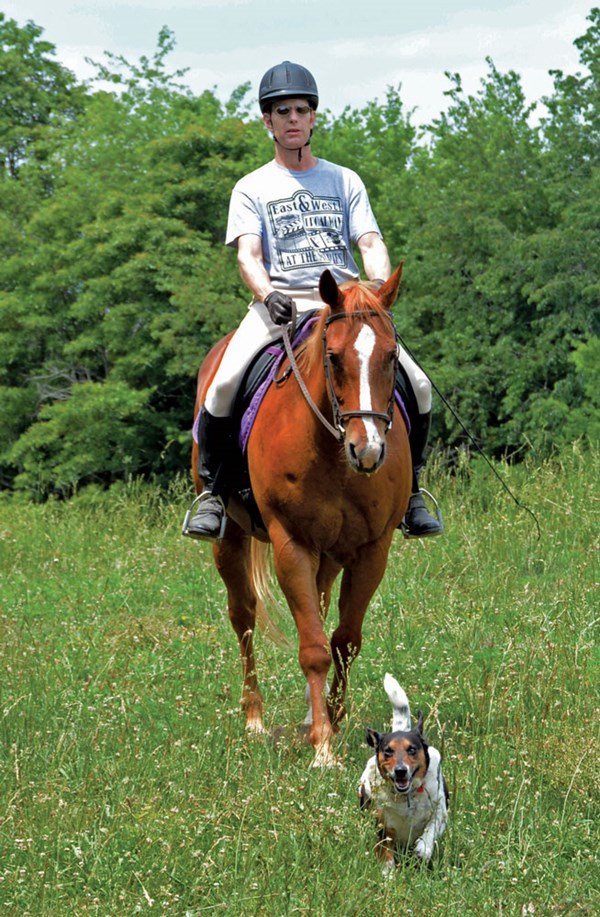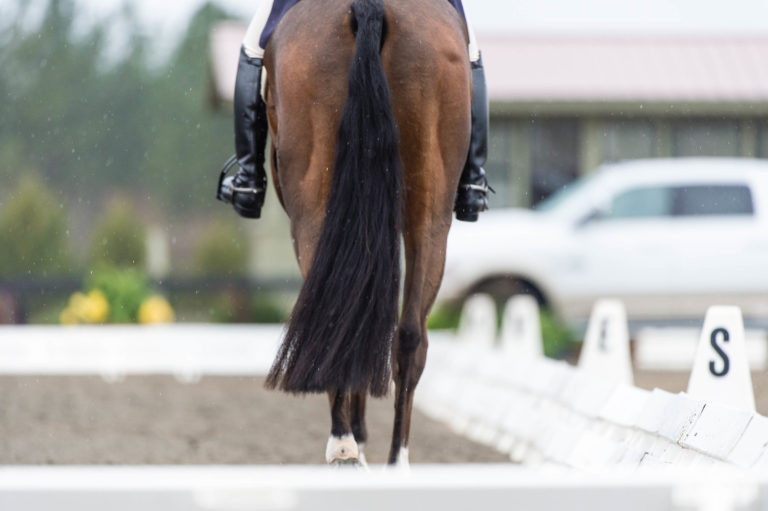
Most long-time dressage riders have heard stories of the struggles and joys of taking up riding after age 50. I have taught many over-50 beginners, but this time I decided to take on a bigger challenge: I am teaching my 53-year-old husband to ride. It wasn’t that I sat down one day and said to myself, I should teach Steve how to ride. Like most things in life, it just happened by accident.
I was cantering my green Andalusian horse, Santana, when I asked him to go right and he went right too quickly for my 60-year-old reflexes. I twisted a knee when I hit the ground, putting me out of riding commission for a few weeks. I had already paid for lessons for the month, so I approached Steve to see if he wanted to take my lessons on a school horse. To my surprise, he said yes to his first riding lesson. I was the official photographer for the big day. I did not realize until that time that he is actually built for riding. Unlike me, he is tall and thin with long legs. Despite his naturally good build, he made the typical beginner errors, including letting the horse stop at the gate, getting his new boots scuffed on the rail and posting out of rhythm.
After the initial lessons, the instructor was kind enough to let us lease the patient old school horse, Madeline. I took up teaching where she left off. It looked so easy, but there was much more time for “discussion” during my instruction. For example, I teach beginners to feel the hind legs come under their seat and ask them to call out “left, right, left, right.” Steve was very quiet for a long time. Finally he started calling out “left, left, left.” I repeated the instruction. After all, he had been in the Army and went to boot camp. He was frustrated enough that he stopped the mare, threw up his hands and said, “This week I can only say left. Maybe next week I will be able to say right.”
Steve was motivated to learn from other instructors and asked me to take him to audit a dressage clinic one weekend. When I wasn’t looking, he pulled up a chair right next to the clinician and asked innocently, “Could you please tell me when the student is cantering and when she is trotting?” The clinician just stared at him and I quickly pulled his chair closer to mine.
Steve was determined to get the sitting trot down pat before attempting the canter, although the horses he rode did not get the memo. One hot summer day, I was giving Steve a longe lesson on Santana. He was doing a great job of coordinating his whole body to sit a very springy trot, and I was busy praising him for this. One minute everything was going well and the next minute Santana took a sharp turn away from the circle and jerked the line out of my hand. My husband’s long legs wrapped around Santana and he cantered off, dragging the longe line after him. I watched breathlessly as Steve slowed his seat and reached down to take the longe line in his hand and turn Santana in increasingly smaller circles until he came to a halt.
As Steve’s eyes on the ground became better and better, he became my ground person. He was so excited the first time he said, “You and Santana are working on the same things I am working on—a steady rhythm for the trot, not falling in on the circle and keeping your hands quiet.”
Boy, I had to bite my tongue not to get defensive, but I realized that he was correct. Just because I started riding as a kid does not mean that it all comes naturally for me. Many rides later, he is still my ground person and he is still helping me with achieving a steady rhythm at the trot, not falling in on the circle and quieting my hands.
Steve’s long-term goal is to ride Santana and show him. He is learning about ground work so that he can improve his timing and sensitivity. Round pen exercises are hard to understand at first and we, as instructors, have to recall our own first attempts. As much as we are reminded of the frustrations, we can also celebrate the achievements. For example, the first time a horse at liberty freely chooses to come to you is very exciting. It was exciting for Steve and he exclaimed, “He picked me instead of smelling the poop!” As the practical clinician JJ Tate often says, “We all have our own Grand Prix moments.”











